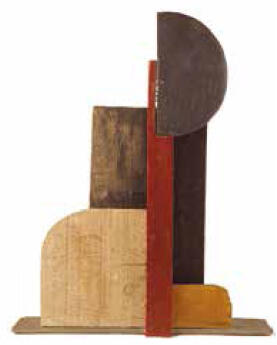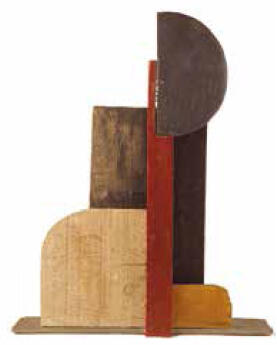Joaquín Torres-García
Instituto Valenciano de Arte Moderno (IVAM), Valencia
As a celebration of its 25 years of existence, the Instituto Valenciano de Arte Moderno (IVAM) explores a part of the creation of Latin America through 127 works of its collection, under the special influence of Uruguayan artist Joaquín Torres-García.

Torres-García’s first years in Spain were a time of Neoclassical training in Barcelona (where he was even a temporary collaborator of Gaudí); he later became a renowned representative of Catalan Noucentisme, characterized by an allegorical realism which, at the turn of the century, is opposed to Modernism. After living in New York, Italy and Villafranche-sur-Mer between 1926 y 1932, while Fauvism, Cubism, and Mondrian and Arp and Helion’s geometric abstraction were booming, in 1926 he settled in Paris. After a successful exhibition, he met Theo van Doesburg and Piet Mondrian. His art began to undergo decisive changes and he started working on constructivist structures and incorporating sign languages. On Torres-García’s initiative, in 1929 the “Cercle et Carré” (Circle and Square) Group and Magazine were created. Below, its original logo of a universalistic nature, which later was also published in Montevideo: 1((1lo
In his essay “Vouloir construire”, he mentions the concepts of reason and construction as essential elements of a universal art, in which the painting is at the same time a part and a symbol of a superior unit.
Torres-García wanted to make constructivism an American art, through the use in his works of signs inspired in the ancient American cultures, transformed into elaborate elements. " I was searching for a new art, an American, avant-garde art, with order, in which geometry arises from the inner structure of the painting".
Torres-García’s palette is fundamentally made up of primary colors, like red, blue, yellow, as well as white and black, in which the influence of his Dutch friends becomes manifest.
The realization of Torres García’s universal proposal required a new art that would incorporate the philosophical and aesthetic ideas of constructivism, yet including the archetypes of Pre-Hispanic cultures. It is a synthesis between the modern and the pre-historic. It attempts to resume the essential aspects of constructivist art and American pre-Columbian arts, such as the sense of universality, the geometrization of forms, the sustained rhythms of the stone walls, the harmonic integration that exists between monuments and their surroundings. It aims at the realization of a monumental contemporary art associated to architecture, the greatest expression of the constructive approach, a nucleus of expressive possibilities that find themselves limited by the use of the easel.
In 1939 he published his essay “Metafísica de la prehistoria indoamericana”, in which he attempts to link the abstract tradition of pre-Columbian art to modern art. After the publication of “Historia de mi vida”, in 1944 he published “Universalismo Constructivo”, in which he summarizes his ideas on the visual arts: “ In my mind, there is no greater conviction than this one: first the structure, then geometry, then the sign, and lastly, the spirit, and always geometry” (Universalismo Constructivo, 1944, page 119).
" I have said Escuela del Sur (‘School of the South’); because actually, our north is the South. There must not be a north, for us, other than that opposed to our South. For this reason we now place the map upside down, and then we already have a fair idea of our position, and not the one the rest of the world wishes it to be. The tip of America, stretching out, points insistently from now on, to the South, our north.”
He inverted the map of South America as a way of announcing the end of the colonial period of Latin American art and the beginning of a new artistic era. Why does he delve in the Greek if he is searching for his own? Why does he study abstraction if he is pursuing the more real? Art, Torres believed, must be able to connect the man of today with “the music of the cosmos”. The modern industrial society has become disconnected from primitive magic art which, as it did in Greece, propitiated in the human spirit a sacred encounter with the deepest and most mysterious reality. That reading led the Uruguayan artist to abandon his European training, and to pursue new artistic horizons.
Upon his return to Uruguay in 1934, at 60 years of age and having become a renowned painter in Europe, he studied indigenous Pre-Columbian art and devoted his energy to the analysis of the cultures and the primitive symbols of the continent.
Latin America held an important symbolic tradition which was relegated by European art. But Torres-García insisted: “ Artists and schools must be forgotten, forget that literature and that philosophy.”
Universalismo Constructivo, Torres-García’s theoretical legacy, of enormous significance to several generations of artists, was published in Buenos Aires by Editorial Poseidón.
The epilog of a fruitful relationship between Uruguay and Argentina was the exhibition Universalismo Constructivo , held at the Museum of Fine Arts in Buenos Aires in 1970.
-
 Objeto plástico - composición, 1931-34. Painted and assembled wood, 20.4 x 16.5 x 3.5 in. /Madera pintada y ensamblada, 52 x 42 x 9 cm
Objeto plástico - composición, 1931-34. Painted and assembled wood, 20.4 x 16.5 x 3.5 in. /Madera pintada y ensamblada, 52 x 42 x 9 cm




